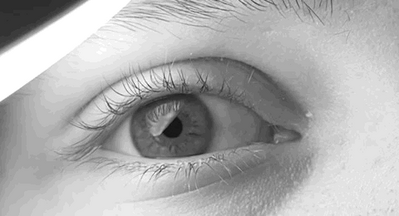Nystagmus
Original Editor - Lucinda hampton
Top Contributors - Lucinda hampton, Kim Jackson, Alyssa Brooks-Wells and Uchechukwu Chukwuemeka
Introduction[edit | edit source]
Nystagmus refers to rapid, involuntary movements that may cause one or both eyes to move from side to side, up and down, or rotate.[1] The nystagmus may be defined by the type of movement observed:
- Jerk nystagmus: a slow beat in one direction and a fast beat in the other
- Pendular nystagmus: the same speed and amplitude in both directions
- Rotary nystagmus: rotational beat on the Z-Axis[2]
These movements can reduce vision, and affect depth perception, balance, and coordination[3]
Some underlying conditions which cause nystagmus can be treated, especially childhood cataracts and strabismus and there are therapies for some neurological conditions and otologic conditions[1].
Etiology[edit | edit source]
There are three categories of etiology of nystagmus:
- Physiological nystagmus, which includes optokinetic, vestibular, and end-point nystagmus, occurs naturally to maintain a clear and steady image of the environment
- Optokinetic nystagmus: a normal reflex that involuntarily occurs with looking at a repetitive moving pattern such as a moving field or trees. It entails a smooth pursuit to track an object and a saccadic jump to the next object repetitively and therefore is a jerk nystagmus
- Vestibular nystagmus: a normal reflex during self-rotation with or without visual input as the inner ear detects motion
- End-point nystagmus: a normal small amplitude jerk nystagmus with end range eccentric gaze[1]
- Infantile nystagmus usually develops by three months of age and the most common types include congenital and manifest latent nystagmus. It is characterized by a horizontal movement and has correlations with conditions such as albinism, congenital iris absence, underdeveloped optic nerves, or congenital cataracts.
- Congenital nystagmus often lessens with convergence or certain angles of gaze which may be used for future interventions
- Although there are theories, there are no definitive reasons proven for why infantile nystagmus occurs [1]
- Acquired nystagmus may develop later in life and entails a disturbance to any portions of the mechanisms controlling gaze stabilization such as:
- Visual system - diseases of this system may lead to nystagmus due to the loss of visual fixation
- Vestibular organ - diseases or dysfunction of this system leads to an imbalance causing mixed horizontal-torsional nystagmus, commonly associated with vertigo
- Central connections - diseases of the central nervous system and its connections to the vestibular system may cause up or down-beat, torsional, periodic alternating, and/or see-saw nystagmus.
- Side effects of drugs (sedatives, alcohol, anticonvulsants) may also produce gaze-evoked nystagmus[1]
Clinical Presentation[edit | edit source]
Symptoms and complaints may include:
- Blurred or jumpy vision - complaints of difficulty with reading or watching television
- Oscillopsia: the illusory sensation the stationary visual world is moving [1]
- Oscillopsia with head movement is indicative of abnormal vestibuloocular reflex (VOR)
- Dizziness
- Vertigo: a type of dizziness that is often described as feeling that you are spinning or that the world is spinning around you [4]
- Loss of balance
- Abnormal head posture -Some people find that their eye movements reduce in certain positions, and they may move their head to maintain this position. This can result in neck and shoulder problems[5].
Diagnosis[edit | edit source]
- When nystagmus is a new symptom and occurs with new dizziness or vertigo, th[6]
- When nystagmus is a new symptom and occurs with new dizziness or vertigo, the patient should get prompt medical attention.
- People experiencing pendular nystagmus for the first time should see a neurologist or neuro-ophthalmologist. Although it is not typically an emergency, pendular nystagmus should be assessed promptly.
- Depending on associated symptoms, the medical practitioner may:
- Order tests such as a brain MRI or blood tests to rule out a potentially dangerous cause e.g. stroke
- Perform an ocular exam
- Perform a vestibular exam
- The type and direction of the nystagmus may be indicative of the cause and help to diagnose individuals
Treatment[edit | edit source]
| Medical Treatment |
|
|---|---|
| Surgical Treatment |
|
| Physical Therapy |
|
| Other Conservative Treatment |
|
References[edit | edit source]
- ↑ 1.0 1.1 1.2 1.3 1.4 1.5 Abadi RV. Mechanisms underlying nystagmus. J R Soc Med. 2002;95(5):231-4.
- ↑ Vision rehab OT The Functional Effects of Nystagmus Available:https://visionrehabot.com/the-functional-effects-of-nystagmus/ (accessed 5.9.2021)
- ↑ Sekhon RK, Deibel JP. Nystagmus Types.2019 Available:https://www.statpearls.com/articlelibrary/viewarticle/43058/ (accessed 5.9.2021)
- ↑ 4.0 4.1 Health Direct Vertigo Available:https://www.healthdirect.gov.au/vertigo (accessed 15.11.2023)
- ↑ Vision Australia Nystagmus Available:https://www.visionaustralia.org/information/eye-conditions/nystagmus (accessed 5.9.2021)
- ↑ Contact Lens King. Nystagmus Eyes Explained | Involuntary Repetitive Eye Movement. Available from: https://www.youtube.com/watch?v=CgaKef1cnTw [last accessed 28/11/2023]
- ↑ 7.0 7.1 Stahl JS, Plant GT, Leigh RJ. Medical treatment of nystagmus and its visual consequences. J R Soc Med. 2002;95:235-237.








